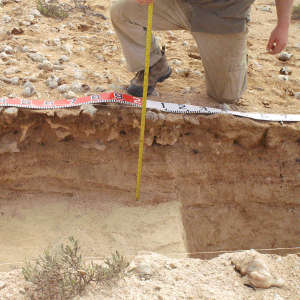Digital wellbeing should be a public health priority for the Arab region
21 October 2025
Published online 26 June 2019
Archaeological shell mounds on southern Red Sea islands provide evidence that pre-historic coastal societies probably ate more shellfish than we thought.

© 2019 Hausmann et al.
Researchers in Germany, the UK, and Australia analysed the contents of shell mounds present on Farasan Kabir Island, the largest in an archipelago of Saudi Arabian coral islands present in the southern Red Sea. The islands uniquely combine remoteness, a sparse population, and a dry climate, leading to a plethora of well-preserved archaeological sites, says La Trobe University archaeologist Matthew Meredith-Williams. Shell middens are sites where marine animals were removed from their shells for consumption. More than 3,000 shell middens had previously been identified in the Farasan Islands.
Samples were taken from various depths in each of 15 mounds chosen for radiocarbon dating. The team also analysed the types of marine shells and other content present in the mounds.
Scientists already knew that sea levels were highest in this area around 6,000 years ago; two meters above today’s levels with a shoreline a few hundred meters further inland. The researchers discovered that the oldest shell middens from among those tested were around 7,300 years old and were located inland in what they refer to as ‘post-shore’ sites, most likely located close to places of habitation. Shells accumulated at a slower rate at these shell middens than they did at those closer to the ancient shoreline. The most recent shell middens were about 4,700 years old.

© 2019 Hausmann et al.
The older post-shore sites located close to places of habitation would have been saved from rising sea levels that happened up to a time 6,000 years ago. Shell processing sites located at the ancient shorelines were all dated to less than 6,000 years, suggesting that earlier sites could have existed but were wiped away by rising sea levels.
“These results suggest that we are actually missing a far more significant portion of this record than initially apparent, and should make clear that losing heritage sites due to sea level changes is not a singular occurrence but guaranteed to happen globally,” says geoarchaeologist Robyn Inglis from Macquarie University, Australia.
Investigations are already underway in some parts of the world to study submerged shell midden deposits using underwater techniques. “The search for the missing palaeoshorelines of the Last Glacial period and their associated coastal sites remains one of the great challenges for the future,” conclude the researchers in their study published in the journal PLOS One.
doi:10.1038/nmiddleeast.2019.93
Hausmann, N. et al. Quantifying spatial variability in shell midden formation in the Farasan Islands, Saudi Arabia. PLoS ONE 14, e0217596 (2019).
Stay connected: